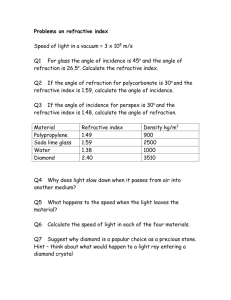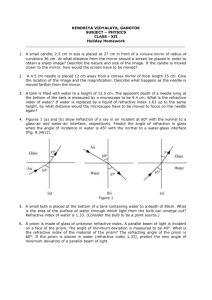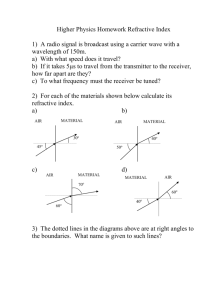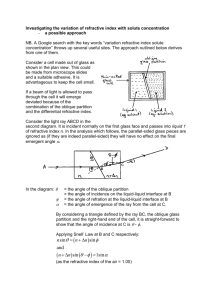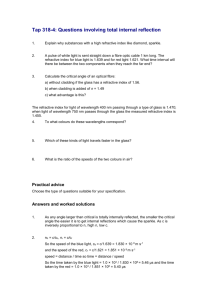Refractive Index Measurement Principle - K
advertisement
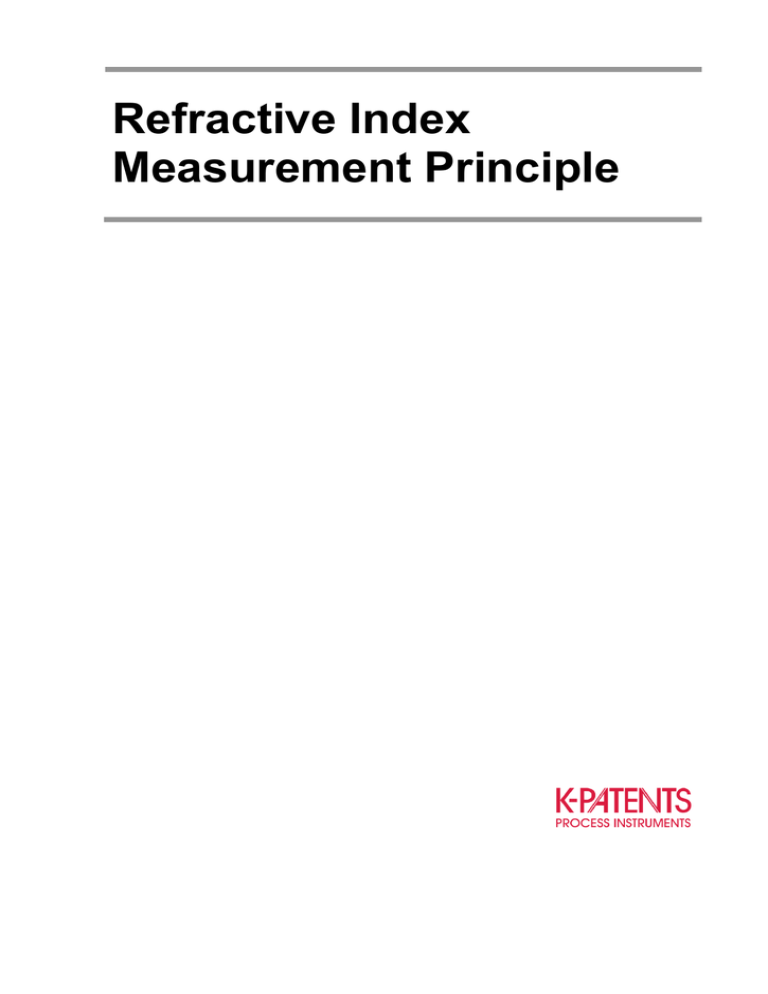
Refractive Index Measurement Principle Refractive index measurement principle Introduction Detection of liquid concentrations by optical means was already known in antiquity. The law of refraction was mathematically formulated first by Ibn Sahl in 984. His discovery was not known in Europe, and usually the discovery is attributed to Dutch astronomer and mathematician Willebrord Snellius (Snell), who rediscovered the law and published it in 1621. The first laboratory instrument to accurately measure the refractive index of liquids was developed by Ernst Abbe in 1874. Speed of light Refractive index measurement is actually a measurement of the speed of light in a medium. The speed of light (usually denoted by c) is 299 792 458 m/s in vacuum. In other media the speed of light is lower than this value, and the refractive index, R.I., of a medium is a measure of how much the speed of light is reduced in the medium. The refractive index (n) of a medium is defined as the ratio of speed of light in vacuum (c) in to that in the medium (v): (1) As the speed of light is highest in vacuum, n is always greater than 1. The speed of light in a medium depends on the medium itself, temperature and wavelength. Due to the wavelength dependency, the refractive index is measured with monochromatic light. The common practice is to use the sodium D-line wavelength 589 nm. The refractive index measured at this wavelength is usually denoted by nD. The temperature is usually 20 °C or 25 °C. Huygens’ principle When studying the wave nature of light, Dutch physicist Christiaan Huygens developed the theory of wavefronts. When a wavefront of parallel light rays enters the interface between an optically denser material ( A) and an optically less dense material (B) at the angle (α) one side of the wavefront meets the interface earlier than the other side. Figure 1 depicts this situation. Because the material A is optically denser and the speed of light in it lower than in material B, the left side of the wavefront travels a longer distance (SB) than the right side (SA). This difference in the distance forces the ray to change its direction. 2 Figure 1. Bending of a light ray at an interface The distances SA and SB are proportional to the velocities: (2) This ratio is the relative refractive index between the two media (n). As the absolute refractive indexes (relative to vacuum) of the media are: (3) the relative refractive index can be written as the ratio between the absolute refractive indexes: ⁄ ⁄ (4) The significance of this result lies in the fact that practical refractive index measurement instruments use some optical glass material instead of vacuum as the reference material instead. The angle of refraction can be calculated by using the simple geometric relations (Fig. 1): (5) These equations can be divided by each other, and the Snell’s law is obtained by substituting the relations given in eq. 4: 3 (6) or: (7) Critical angle If the medium A is optically denser than B, the angle β is always greater than α. Be reorganizing the equation 7, the angle β can be calculated: (8) When the angle α is increased, β reaches 90° at some point, and the bent rays travel along the surface (see figure 2). If the angle α is further increased, the light cannot enter material B. Instead, it reflects back to A. This phenomenon is called total internal reflection. Figure 2. Ray at the critical angle The angle αc at which sin β = 1 is called the critical angle of refraction, and it can be calculated as: (9) The refractometer measure the angle αc. As nA is the well-known refractive index of the measurement prism, the refractive index nB of the sample can be easily calculated by using eq. 9. 4 Measuring prism The measuring prism provides the interface between the instrument and the medium which is measured. The geometry of the optical system is such that light rays at a certain selection of angles α are projected onto the prism surface. The actual angles are chosen so that the desired refractive index range can be measured, i.e., the critical angle is always within this selection. The measuring prism acts as the refractive index reference. The refractive index of the prism has to be higher than that of the medium under measurement, as otherwise there will be no total internal reflection. In practice, the difference of refractive indexes has to be relatively high. The prism material has to be chemically and mechanically as durable as possible. The material has to be optically homogeneous and preferable isotropic (similar to all direction). These requirements limit the choice of materials considerably, and different applications may require different prism materials. Optical image Figure 3 depicts the analyzer part of the optical system in a typical refractometer. All light rays coming from the prism and entering the optical system at the same angle α are focused onto a single point on the image detector (CCD). The distance d between this point and the axis of the optical system depends only on the angle of the incoming light. This way the angular distribution of the light can be converted to light position distribution on the CCD. Figure 3. Analyzer optics of a refractometer All modern refractometers convert the optical image into digital information. Figure 4 shows a typical optical image. On the left side of the critical angle all light undergoes total internal reflection, and the intensity of light is high. On the right side of the critical angle the intensity falls rapidly, as most light enters the sample and is not reflected back. 5 Figure 4. Optical image of a critical angle refractometer The digital image analysis algorithm determines the point on the CCD corresponding to the critical angle. It may also determine some diagnostic values related to the image quality. R.I. measurement After the critical angle position d is determined, the angle α has to be calculated. As the relation between d and α depends only on the geometry of the optics, this angle is straightforward to calculate. The actual formula depends on the optical system itself. The equation 9 gives directly the refractive index when the critical angle is known. Precision of the measurement can be verified by measuring R.I. standard liquids. Accuracy of the refractive index measurement carried out with this principle is typically ±0.0001 in refractive index. Concentration In most solutions, the concentration of solute in a solvent can be determined by measuring the refractive index nD. The relation between the refractive index and the concentration depends on the solvent and solute, temperature, and wavelength. In practice, the wavelength-dependency (dispersion) is avoided by using monochromatic light. The temperature dependency is eliminated in laboratory measurements by thermostating the sample, but in process measurements it has to be compensated by using a compensation formula. The actual numbers vary between different solutions, but usually one percent of concentration corresponds to approximately 0.002 in nD. One centigrade in temperature corresponds to 0.0001 in nD in aqueous solutions. The temperature dependency is usually higher with other solvents. These numbers show the need of temperature measurement and compensation, as a change of one centigrade corresponds typically to a change of 0.05 % in concentration. 6 The temperature compensation is not a linear function. Both the temperature and the concentration change the amount of temperature compensation required. Also, the relationship between concentration and refractive index in nonlinear. The concentration can be calculated from the refractive index and temperature when these nonlinear functions are known. There are several possible temperature compensation algorithms. In practical use, a simple 3rd degree polynomial in both temperature and concentration (total 16 coefficients) is sufficient. 7
